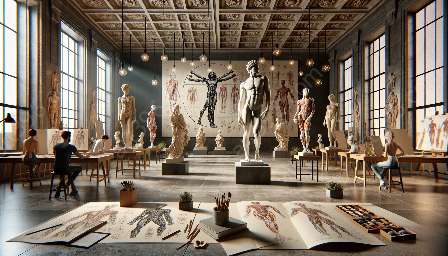Art is a powerful medium that often seeks to reflect the human experience in all its complexity. Within the realm of artistic anatomy, the portrayal of sensitive or vulnerable subjects carries ethical considerations that can deeply impact both the artist and the viewer.
Understanding Artistic Anatomy
Artistic anatomy is the study of the structure and form of the human body as interpreted and depicted by artists. It provides artists with a foundational understanding of the body's skeletal, muscular, and organic systems, enabling them to accurately represent the human form in various artistic mediums.
Ethical Considerations for Anatomical Accuracy
When artists portray sensitive or vulnerable subjects, such as individuals confronting physical or emotional hardships, ethical considerations surrounding anatomical accuracy become paramount. Inaccurate depictions can perpetuate harmful stereotypes or misrepresent the experiences of these individuals, causing distress and perpetuating stigmas.
Respect for Subject Integrity
Anatomical accuracy in art must prioritize the respect and integrity of the subject. This may involve obtaining consent from the individuals being depicted, ensuring their dignity and privacy are upheld, and representing their anatomy in a truthful and respectful manner.
Consideration of Impact
Artists must consider the potential impact of their work on viewers, particularly when portraying sensitive or vulnerable subjects. Anatomical accuracy should serve to deepen empathy and understanding rather than sensationalize or exploit the subject matter.
Intention and Narrative
The artist's intention and the narrative they seek to convey through their work play a crucial role in ethical anatomical representation. Artists should strive to depict the human form with sensitivity and nuance, avoiding gratuitous or sensationalized portrayals that serve only to shock or provoke.
Intersection of Artistic Anatomy and Ethics
The intersection of artistic anatomy with ethics is multifaceted. It involves balancing the pursuit of anatomical precision with a deep consideration for the human experience and the impact of art on individuals and society. Artists must navigate the responsibility of accurately representing the human form while upholding ethical principles and respecting the dignity of their subjects.
Impact on Artistic Expression
Consideration of ethical implications related to anatomical accuracy in art when depicting sensitive and vulnerable subjects can profoundly influence artistic expression. Artists may find themselves exploring new forms of representation, seeking to convey depth of emotion and experience while remaining mindful of the impact on their audience.
By engaging in thoughtful and ethical practice, artists can harness the power of anatomical accuracy to create art that resonates with authenticity, compassion, and respect for the subjects they depict.

